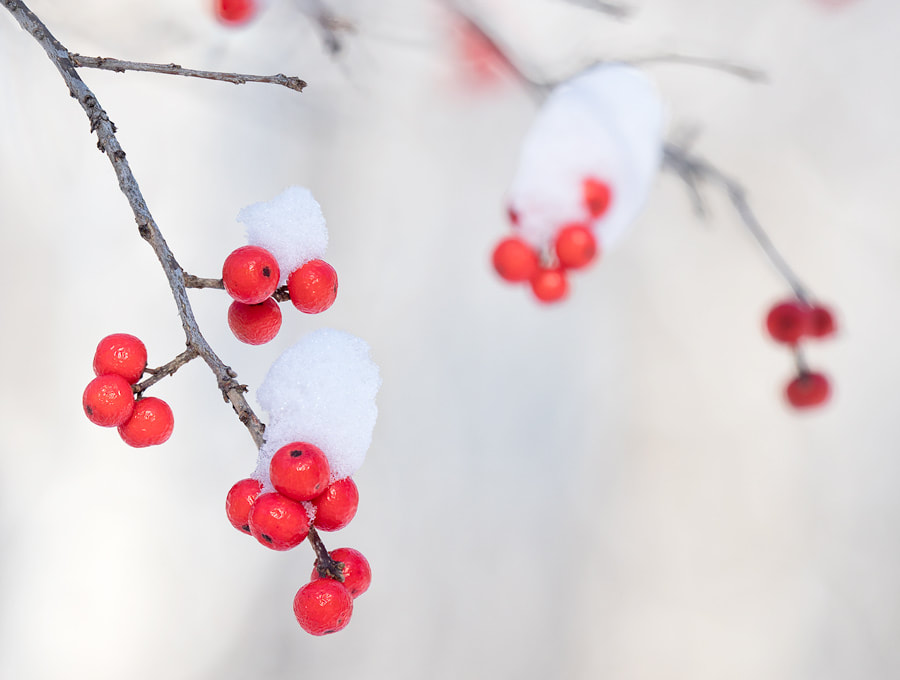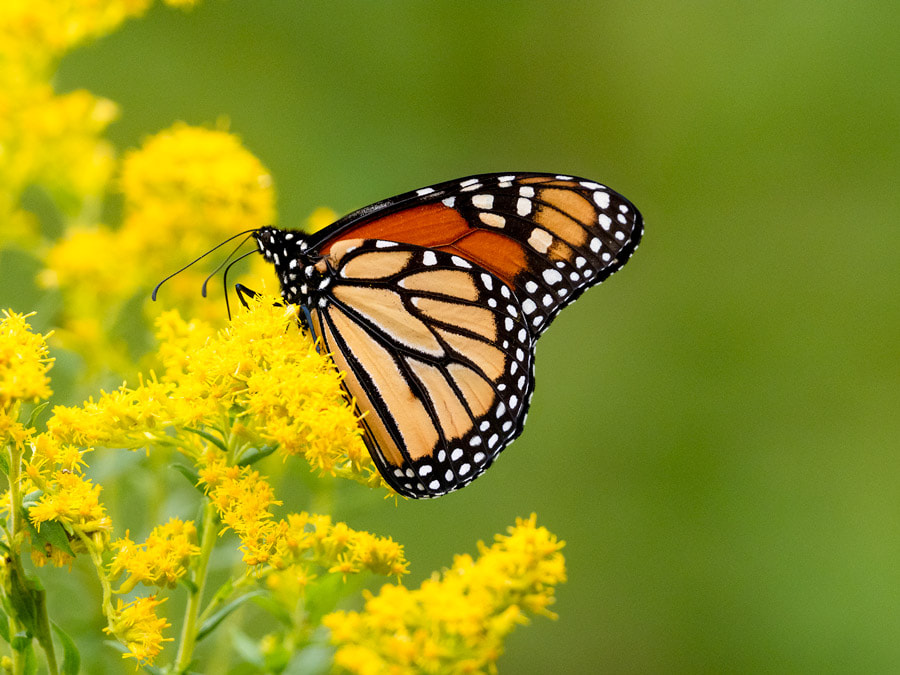|
Getting in Close from Far Away Okay, bring your camera in close... Closer... A bit closer... There! Perfect! When you want to get in real close to your subject, you are entering the realm of the macro photographer. Usually this means you need a specialized macro lens, one that allows for extremely close focusing distances and provides a reproduction ratio of at least 1:1. For some subjects this may be your only choice, for example, capturing the minute details of an insect. For situations like that I will grab my Olympus 60mm f/2.8 macro lens. But often I want to capture a great close-up of my subject, giving it the macro 'feel' without actually being all that close. That's when I put on a longer lens and turn to telephoto macros. Advantages Using a telephoto lens for your close-up shots comes with several advantages over a regular macro lens;
Lenses Olympus makes a variety of telephoto lenses. Given their minimum focusing distances they are excellent for macro-style shooting even if they aren't true macro lenses.
Shooting Tips
Beautiful Blur The best compositions are often the simplest ones. The easiest way to isolate your subject and make it stand out is to have a blurry, or defocused background. In large part this is determined by your choice of aperture, which not only establishes how much of your subject is sharp, but will also determine the degree to which your background blurs. A large aperture will create a softer background, but may not provide you with enough clarity throughout your subject. So achieving the perfect result is a bit of a balancing act and may require some experimenting with different aperture settings. Selecting a subject that is set a fair distance away from the background will also help isolate it in your final composition. One option is to use the focus bracketing and stacking built into the OMD line-up of cameras. This allows you to use a larger aperture to achieve nice bokeh yet still have your entire subject in focus. With this technique however, having a subject that is quite still is key to getting good results.  In order to separate this fence from the distant trees I utilized a fairly large aperture. This created the defocused background that I wanted, but not all of the frost was in focus with a single shot so I used focus bracketing as well. (Olympus E-M1 Mark II, 40-150mm f/2.8 PRO @ 150mm, ISO200, 1/1000s @ f/3.5) One technique that I like to use on occasion is to add blur in front of the subject as well. This adds a creamy softness to the foreground and the illusion of extra depth. This is achieved by placing your camera in amongst some foliage or flowers, often just a few inches away from the front lens element. A Backyard Safari One of the biggest advantages to using a telephoto lens for your macro-style shooting is the ability to capture a bit of 'wildlife' along with the beautiful blooms. It is a lot harder to sneak up on a butterfly sipping nectar using a macro lens. With a telephoto lens you can be several meters away and still have your subject fill up much of the frame. This will require a closer look at your camera settings since having a faster shutter speed may be important, depending on whether you are trying to capture the insect or bird in flight versus at rest. There are a couple of approaches to consider;
Final Thoughts and Images I often use macro photography as a quick escape. Whether I use a true macro lens or one of my telephoto lenses it is a great way to get out of the house for a short period of time and explore my immediate surroundings. It also helps me focus on the details when I'm out shooting landscape images. If you are new to this style of shooting it is good to experiment using a telephoto lens that you already have. You can practice good field technique before making the investment into a dedicated macro lens. For more information on macro shooting you can check on this article on focus bracketing and stacking.
14 Comments
Marcel
5/6/2020 04:38:26 pm
Inspiring article. Since I own both the 60mm macro and the fabulous 40-150mm f2,8, I sometimes do macro photography with these lenses, but I have to practice more with focus bracketing and stacking. BTW, great blog and great photos. Thanks
Reply
Kanchan
7/4/2021 04:32:41 am
Can i used zoom lens in mobile
Reply
Mary
5/6/2020 05:01:52 pm
I have enjoyed your article about telephoto macro. I have an Olympus 5 II and am on the verge of purchasing the 40-150 pro. My question is which converter should I get. Will the 1.4 give enough reach for flowers and birds? Also can the camera be handheld with the 1.4 and /or the 2 x?
Reply
Tom
5/6/2020 08:29:13 pm
Thank you for the good ideas and beautiful images. I had been using an Olympus Stylus and enjoying it including its macro capabilities, but the 150mm maximum wasn't long enough for my interest in bird photography. So I splurged on an OMD M1 and the 75-300 lens. I was very pleased with the increased length and the additional capabilities of the M1. But I was pleasantly surprised to discover its ability as a telephoto macro. It allows me to be watching up close and to the distance during my "river walks".
Reply
Sergei Gridnevskii
5/7/2020 07:06:28 am
I did a couple of macro shots with Sigma 50-500 + 1.4x lens with Olympus E-MII. Scale was about 1:1 at 1400mm. Of course from tripod.
Reply
Jim A.
5/12/2020 10:02:14 pm
These photos and tips are just outstanding. Thanks for sharing your vision with us, just fantastic work.
Reply
Graham Lovis
6/15/2020 07:07:20 am
Thank you again Peter for yet another excellent article, accompanied by stunning photographs.
Reply
Doug Fenichel
9/22/2020 03:45:24 pm
I've been using "tube extenders" to accomplish macro photography. My budget wouldn't allow me to purchase new macro lenses, but it works with the lenses that I have. Still try to figure out bracketing and stacking (camera doesn't do it automatically)
Reply
12/9/2020 01:04:34 am
It really helped when you said that it would be best to hire the photographer in advanced
Reply
Viktor
2/22/2021 10:08:57 am
Nice article! Nice to see someone using 300 f4. I have an old Sigma 300 f4 that goes to 1/3rd, my favorite "macro".
Reply
Janice Gursanscky
3/22/2021 07:14:35 am
Another great article thanks Peter. I love macro photography
Reply
3/25/2021 07:57:17 am
I loved your blog and thanks for publishing this about shooting telephoto macros !! I am really happy to come across this exceptionally well written content. Thanks for sharing and look for more in future!! Keep doing this inspirational work and share with us.
Reply
6/13/2021 07:04:42 am
Amazing article! Beautifully explained how and why telephoto lens could be better than traditional macro lens. Best point is you don't cast your shadow on the subject while capturing an image, plus you still get beautiful bokeh. Thanks for sharing!
Reply
Leave a Reply. |
AuthorPeter Baumgarten is a professional photographer and educator. He is also an Olympus Visionary and NiSi Official Photographer. Categories
All
|














